While working with our tool of analysis of passenger traffic of the Ukrainian Railways (Ukrzaliznytsya, hereinafter UZ) Mykhaylo Stronsky, a reader of TEXTY, noted irregular traffic at Kyiv-Dniprovsky, a station in the capital city, which usually does not accept passenger trains.
The dates of arrival of trains to minor stations (i.e. other than Kyiv Central Station and Darnytsya) turned out to match the dates of mass Anti-Maidan rallies and provocations of the "titushky" (militants of the Party of Regions) in January and February 2014.
We do not know whether there were militants among the passengers of those trains. We do admit that they could be employees of public bodies and state-owned companies forced to participate, or "Maidan wetbacks". However, they earned their money by creating an image of popular support of Yanukovych's regime. On this background, real thugs began in turn to maim and kill protesters.
Trains, Wagons and Passengers
We identified in total 17 pairs (that is, roundtrip — back and forth) of extra trains that arrived to the 4 minor stations within Kyiv's boundaries. The departure stations were: Simferopol, Donetsk, Luhansk, Kherson, Mariupol, Kharkiv-Central Station.
The dates of arrival to Ukraine's capital January 16, 23, 28, and February 20, 2014. Departing the day before, the trains arrived to Kyiv between 5am and 9am. The same evening they all went back to their points of departure.
"The practice of receiving and departing of trains from these stations instead of Kyiv Central Station has existed from the time of first mass transports of soccer fans in extra trains," — commented the situation Maxym TABACHUK, the owner of Railwayclub.info online project, who was among the developers of the Express-UZm automated ticket sale system at UZ. "The trains are received at those stations to avoid problems with public order at the main stations." That time there was one more reason to implement the familiar routine: to avoid attention of the public and mass media.
Those trains all consisted of 19-22 wagons. In almost every train there was a 1st class wagon (32 seats), and the rest were ordinary economy class carriages (54 seats).
"The Party of Regions had been doing so since at least 2007, when they brought people to The Maidan (Independence Square rally) and other rallies in Kyiv," says Maxym Tabachuk. "Yet already then it was possible to expect what kind of people were supposed to transport by those extra trains consisting of one 1st class and the rest of economy class wagons. The customer, I assume, would rather have all the economy class wagons, but the ones to accommodate the leaders is usually 1st class, so thay had to leave a single 1st class wagon in each train."
An average train contained some 1,020 passengers. That is according to the official statistics of the tickets sold, although the customer could have loaded 1.5 times as many "Maidan wetbacks" and "titushky" militants.
"There were three guys on each bottom seat," describes his trip conditions one of the authors' informant (a resident of Zaporizhia), who decided to see the capital city for free and to earn some money in exchange for brandishing Yanukovych's portrait, and so traveled by one of the mentioned Simferopol-Kyiv trains.
"When the whole wagon is paid by the customer, it's up to the latter to fill it with passengers without fixed seats, there's nothing illegal in it", notes Maxym Tabachuk. It is possible even to transport standing passengers. As long as the number does not exceed 150 per wagon, the rules are observed.
The number of tickets sold in both directions matches in all the 17 cases — the count of the departed and the returned is exactly the same. These data is just the count of the tickets sold from the UZ database, without names.
Who traveled in those trains, and how many there were, can be established only by an official investigation. There was probably rotation of the "titushky" and other paid participants of political rallies.
"tourists" have been carried by Yanukovych Trains
How Many Were There and Where Did They Arrive?
Most often the trains arrived to the station Kyiv-Moskovsky (a bit above 7 thousand, or 41% of all the guests of the capital city). Out of regular long-distance trains, they barely serve speed commuter trains of the "regional" category.
The station has a complex network of platforms and tracks, and there are no inhabitants nearby that could use it; on the other hand, it is the closest to the Mariinsky Park where the Anti-Maidan camp was located.
The next one, by the number of activists of the Party of Regions received, is Petrivka station (5020 passengers, i.e. 29% of the total number of the guests). Passenger trains barely stopped here in early 2000s at the time of reconstruction of Kyiv Central Station.
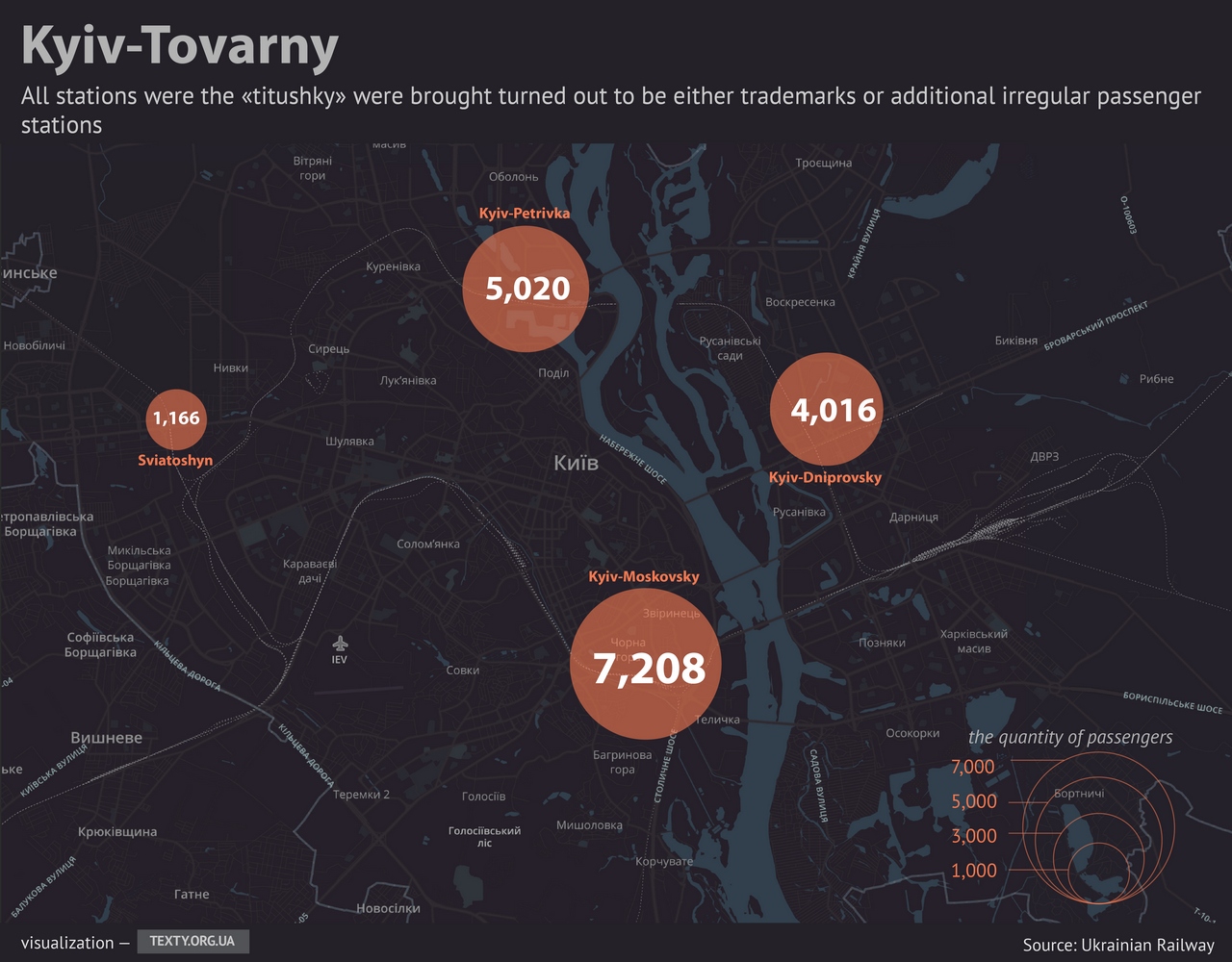
A bit fewer guests (4016 people, or 23%) arrived at Kyiv-Dniprovsky station, located 0.5 km (0.3 miles) away from Livoberezhna metro station. In the Soviet time it used to receive so-called "tourist trains", but currently even local commuter trains no longer stop here.
A single extra train (Kyiv — Simferopol, 1,166 passengers) arrived on January 16 to Sviatoshyn station. At that point, the station was serving only speed commuter train of Korosten direction out of all the long-distance trains; it is this traffic that is marked white on the information chart.
Dates of Arrival to Kyiv
The dates of arrival of extra trains to minor railway station in Kyiv coincide with key events of the Euro-Maidan and/or Maidan rallies.
On January 16, 2014 early in the morning 5,988 persons came to Kyiv by 6 extra trains, two from Crimea and one from Donetsk, Luhansk, Mariupol and Kherson, respectively.
On that day the deputies have been voting for two hours by show of hands for the notorious "dictatorship laws" introducing de facto criminal persecution for participation in mass rallies (which was classified as extremism), censorship (libel and slander), stripping opposition deputies of their parliamentary immunity while establishing immunity for Berkut squads and corrupted judges.
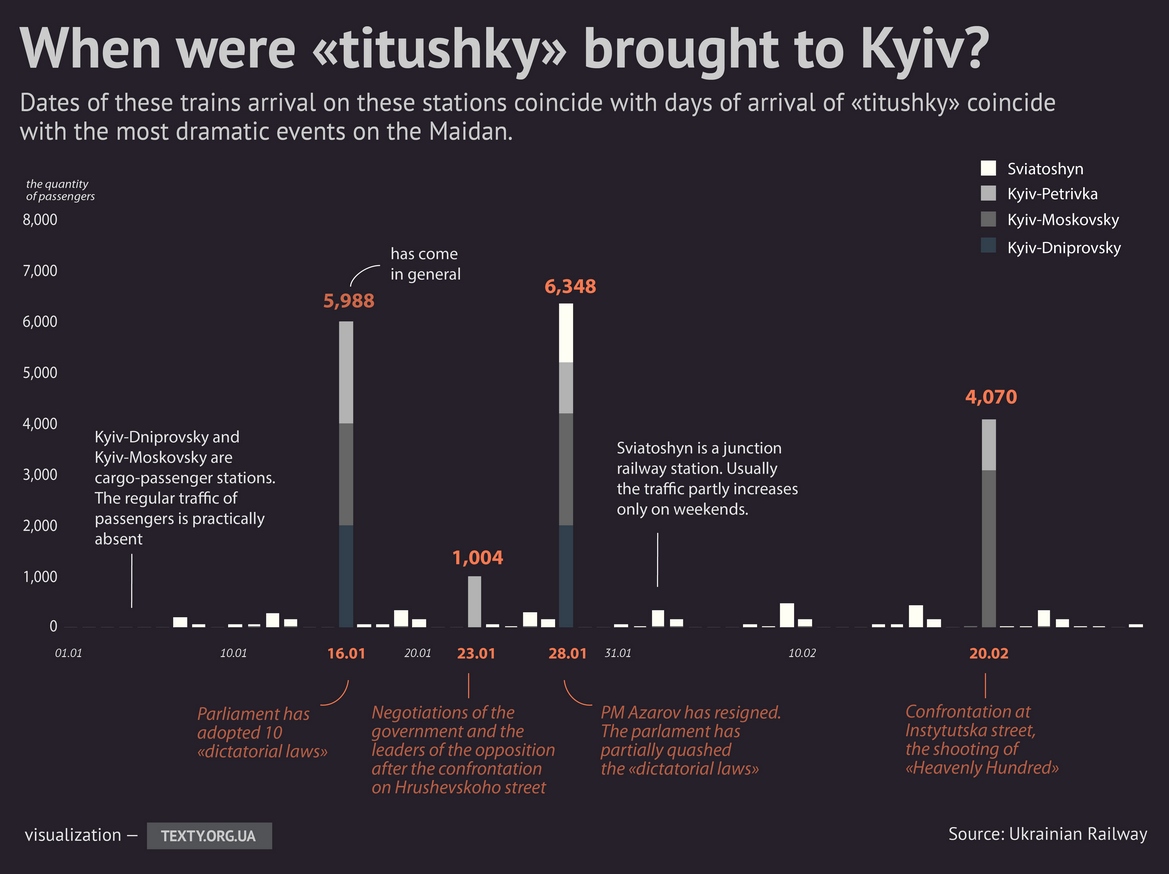
These parliamentary decisions were accompanied by mass rallies of many thousands of "supporters of the current government" specially brought to Kyiv, who created their Anti-Maidan tent camp in Mariinsky Park. From 10am their columns were moving towards the Rada from Pechersk Monastery and the tourist parking at the World War II Museum. The buses carrying the "rally wetbacks" from the minor railway station could unload them at the same spots. Formally the visiting demonstrators were rallying to prevent the opposition from blocking the passage of the Budget Act 2015. Their overwhelming majority was most probably not aware of what was going on in the parliament and what 1threat it was posing to the country.
It was the last mass action in a usual peaceful environment. The opposing camps did not exchange with punches, rocks and bullets but just shouted their slogans at the most. As was before, the "visiting Maidan workers" brandished with banners they received from the organisers, walked down the streets of Kyiv, argued with their opponents drinking some "shots of tea", received a hundred of hryvnya each and went back, three persons per shelf. The extra trains left the capital city just when Yanukovych signed the "dictatorship laws".
On January 23, 2014 only one such train came to Kyiv — it was from Kherson. Apparently its 1,004 passengers were supposed to "work as pixels" by demonstrating the popular opinion on the eve of the announced negotiation between the opposition leaders and president Yanukovych. Over the week that passed after the previous trips of the "visiting Maidan workers" to Kyiv the street protests changed as never before over the last two decades. Real street fighting broke out with Molotov cocktails and grenades and bullets in response.
The tickets for the extra train Kherson-Kyiv were sold out within 11 minutes, from 11:10 to 11:22 on January 22. By then only two firearm deaths of demonstrators were known. As the extra train #573Sh was leaving Kherson, the owners of offices at Khreshchatyk Street were ordered to evacuate their personnel, lock the doors and close the windows. People of Kyiv brought rubber tires to Hrushevsky Street to create a smoke screen preventing the police squads from targeting the demonstrators.
Early on January 23, when the passengers of the mentioned train were getting off on the platform of Petrivka station, five deaths from shots and tortures were already known. In the afternoon the "political tourists" were brought to their destination point, Mariinsky Park. There began another rally of the president's supporters. Against the background of this rally Yanukovych announced his readiness for negotiations and concessions.
On January 28, 2014 a record number of "part-time political workers" arrived to Kyiv by railway: there were 6,348 passengers in six extra trains, two from Simferopol and one from Donetsk, Luhansk, Mariupol and Kherson, respectively. All access to the government district was blocked by vehicles and concrete slabs. Only the "Maidan part-timers" were allowed to pass this perimeter: they were heading to the main camp in Mariinsky Park and to the pro-government rally at the Parliament. Encircled by the "visiting activists", the Parliament voted for partial abrogation of the January 16 Laws. An amnesty of Maidan activists was promised in exchange for ending the street protests. The opposition labeled the document the "hostage law".
On February 20, 2014 four extra trains with Maidan workers and "titushky" arrived to Kyiv: one from Donetsk, one from Kherson and two from Kharkiv (4,070 passengers). Up until that point the Kharkiv direction was not part of our research. At the same time the Ukrainian Railways announced suspension of traffic heading from the west "for an indefinite period". The passengers from the east arrived to the stations Kyiv-Moskovsky and Petrivka early, between 5am and 6am. Around 7am they were noticed at Vydubychy and Podol.
Two and a half hours later a representative of the Party of Regions, Kalashnykov, held a speech in front of the guests and appealed for mobilization. During his speech over 30 people were shot at Instytutska Street. By the end of the day the total of the demonstrators killed was brought to a hundred. Such an overt mass execution shocked Ukraina and put an end to Yanukovych's rule. He was quickly defected by the majority of the Regions Party deputies, the Berkut squad left Kyiv in panic, and the Interior Troops surrendered to the Maidan Self-Defence.
The "titushky", who lost their coordinators, scattered all around in Kyiv.
Kherson is a Champion
The record by the total number of Anti-Maidan passengers was set by Kherson city (5,020 one-way tickets). It was the only city sending extra trains to the capital city on all the 4 days mentioned in our research; in total there were 5 pairs of trains, yet another record. The tracks of these both extra trains from Kherson pass Mykolaiv, where they could load extra passengers from local "part-time political workers".
In March 2016 Kherson Directorate of the National Police announcedthat the total of the region inhabitants who had traveled to the Anti-Maidan in Kyiv was 6 thousand people.
The Facebook community Euromaidan identified Hanna Ponomarenko, then deputy head of Kherson Regional Administration, a veteran of the "bodies of interior affairs", an activist of the Party of Regions and the engine of the local Anti-Maidan, as the organiser of those train trips.
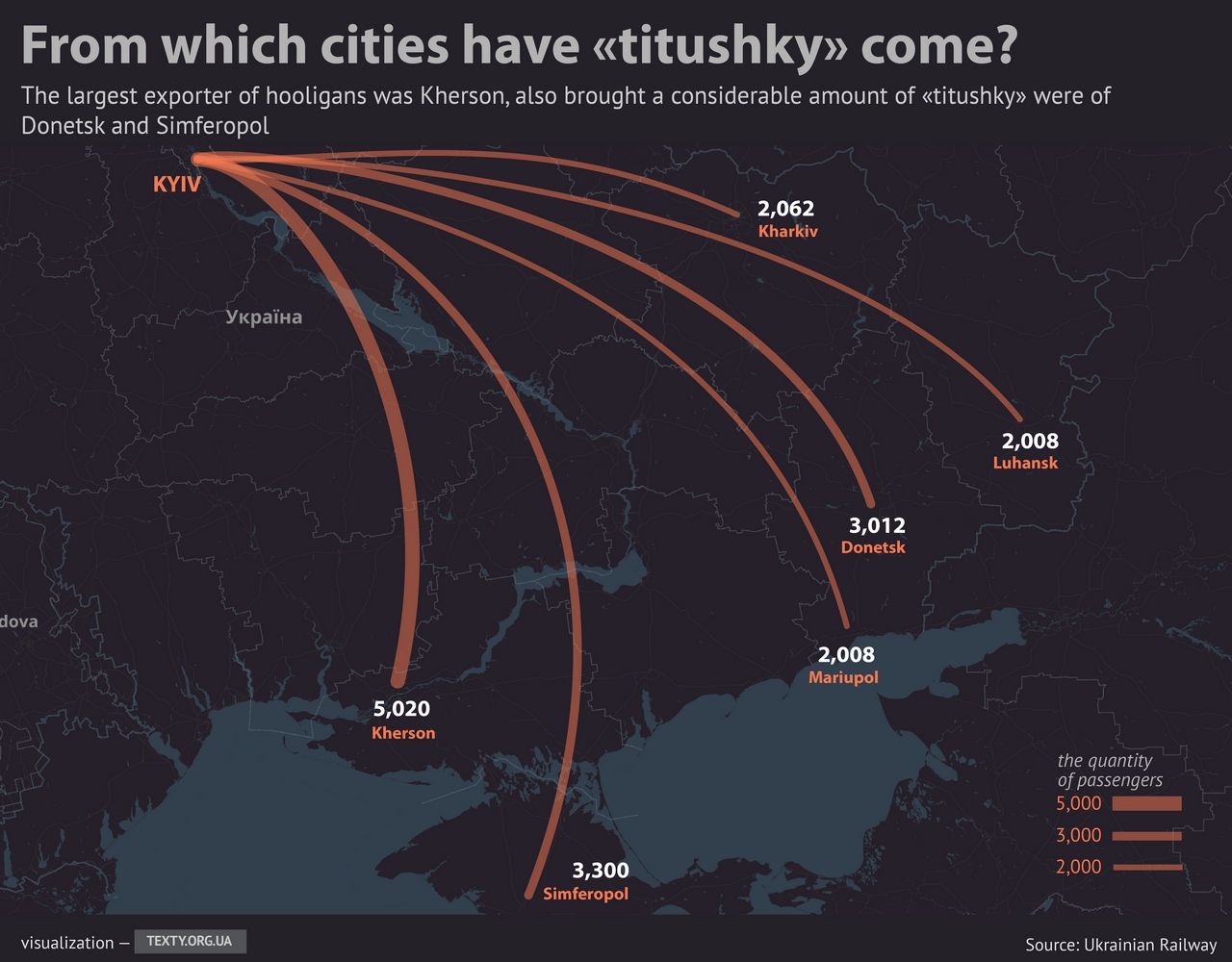
The police has questioned 4 thousand inhabitants of Kherson out of the participants of the trips to Kyiv organised by the administration and the Party of Regions. All the people questioned stated that they took those trains voluntarily, without any coercion. Three criminal cases (against the leading members of the regional administration, the sea port and one of the district — note it! — sports schools) were closed.
The second place took Simferopol (3,300 passengers, 3 pairs of trains, arrival to Kyiv on January 16 and 28). The route of the Crimean train covered Zaporizhia and Dnipropetrovsk.
A bit less tickets were sold for the extra train #585 from Donetsk (3,012 passengers, 3 pairs of trains, arrival on January 16 and 28, and February 20), which had a stop in Dnipropetrovsk.
Railway traffic of the "Maidan workers" from Kharkiv was noticed only on February 20, namely 2,062 passengers, 2 pairs of trains (#501/502 and #503/504).
Mariupol and Luhansk sent 2008 "workers" each (judging by the tickets sold) in two pairs of trains. They arrived to Kyiv on January 16 and 28. The train route #592 from Mariupol included Donetsk, and #578 from Luhansk included Poltava.
How Much Did It Cost?
All the seats were paid for the whole itinerary, even when the passengers got on at intermediate stops. For this reason we cannot establish how many people got on the Kherson train in Mykolaiv, or in the Crimean train in Zaporizhia. On the other hand, we do know how much this "feast of democracy" cost to the customer.
Those who ordered the 17 pairs of extra tickets spent on them 4.36 million hryvnia in total. The average cost of a single "Maidan worker's" rooundtrip itinerary to and from Kyiv was 250 hryvnia 28 kopecks.
One can also establish whether the tickets were paid in cash or otherwise.
The rules of railway traffic (paragraph 2.37) set forth that "a single person can purchase up to 9 travel documents at a time at a single ticket office." All that exceeds this limit is considered a group purchase and should be paid by a bank transfer.
One can distinguish in the data analyzed the purchases of specific wagons (54 seats in economy class wagons and 36 seats in the first class) from those of separate tickets (9 at a time). The last case meant payment in cash.
In total, 78% tickets (27,144 seats) were paid in cash, 3,444,858 hryvnia. It would make up a 3.4m tall pile of imaginary 200 hryvnia banknotes.
Only 7676 seats for 912,606 hryvnia and 8 kopecks in total were paid by bank transfers. In the latter case we mean the 2 pairs of trains Kherson-Kyiv-Kherson (January 22—23), 2 pairs Simferopol-Kyiv-Simferopol and one train LLuhansk-Kyiv (all on January 27—28).
It is noteworthy that the purchase of tickets for the trains Kharkiv-Kyiv-Kharkiv in cash involved a discount scheme, which allowed the purchasing persin to embezzle almost 30 thousand hryvnia.
Out of the 4064 tickets purchased on February 19, 2014 for the extra Kharkiv trains, 297 seats were purchased with discount for "orphaned kids", and 112 seats with the discount for "handicapped kids under 16 years old".
"The orchestrators of the scheme were aware that such trains are never checked by the ticket control", assumes Maxym Tabachuk. "This is why they could easily transport an adult person with a child ticket".
As a result, the Ukrainian Railroads lost 29,476 hryvnia.
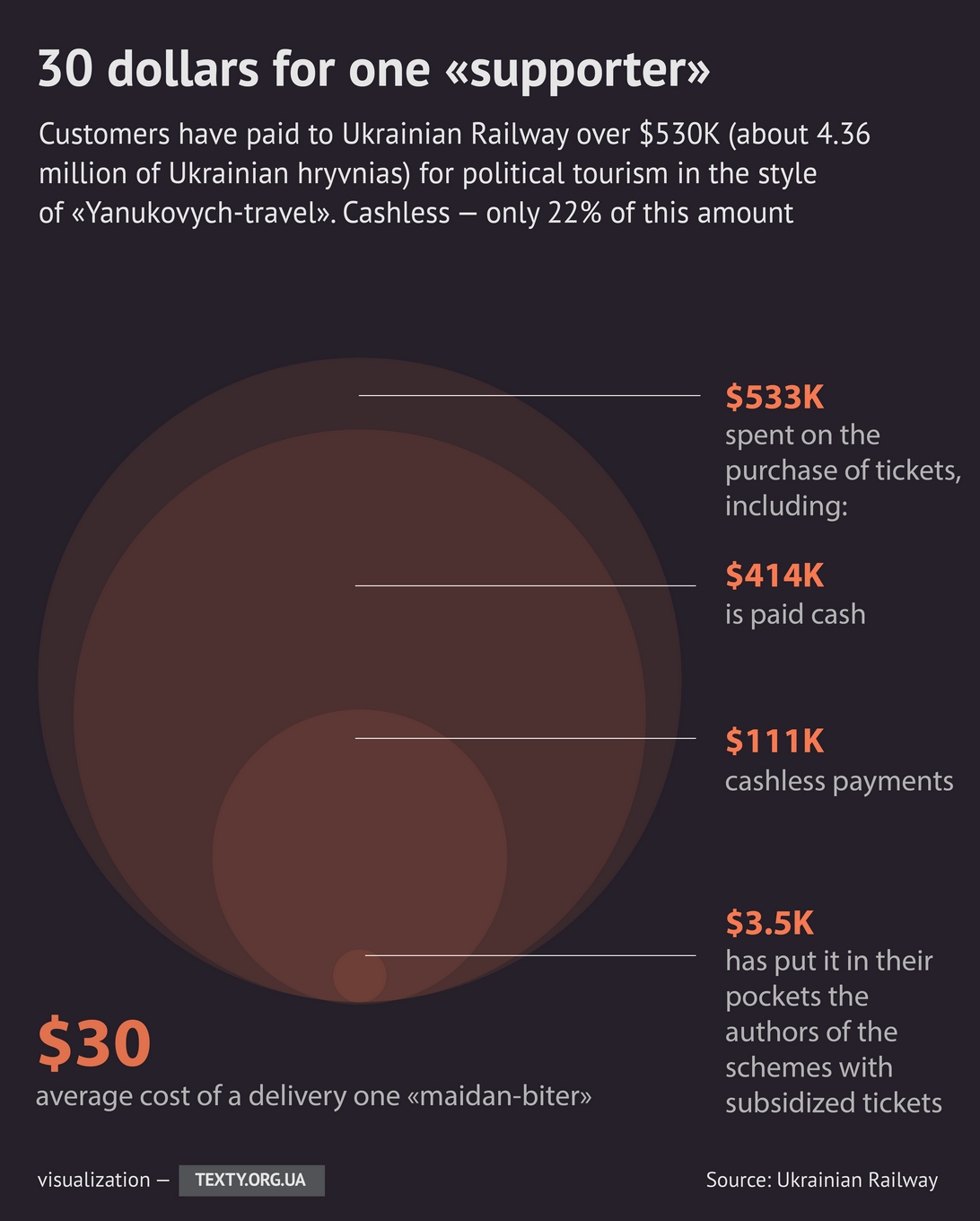
When Were the Tickets Purchased?
The data available allow to establish the date and time of the ticket purchase. It is impossible, however, to establish the geographic location of the purchase, because UZ did not provide the numbers of the Express system terminals where the purchases took place.
"The purchase time indicated in the ticket is when the transaction was registered in the database. It can differ from the actual time of ticket purchase in a terminal, but only by seconds," explains Maxym Tabachuk. "Whatever the case, the customer must have had a prior agreement with someone in the Railways management. Only then they prepared the documents and performed the payment, and only after that the data were registered in the system [from where they leaked to TEXTY]".
One can observe certain simultaneity: for example, they began to purchase tickets for the extra trains on January 16, 2014 from Simferopol and Luhansk at the same time on January 14. On January 27 the same happened to tickets from Donetsk and Mariupol.
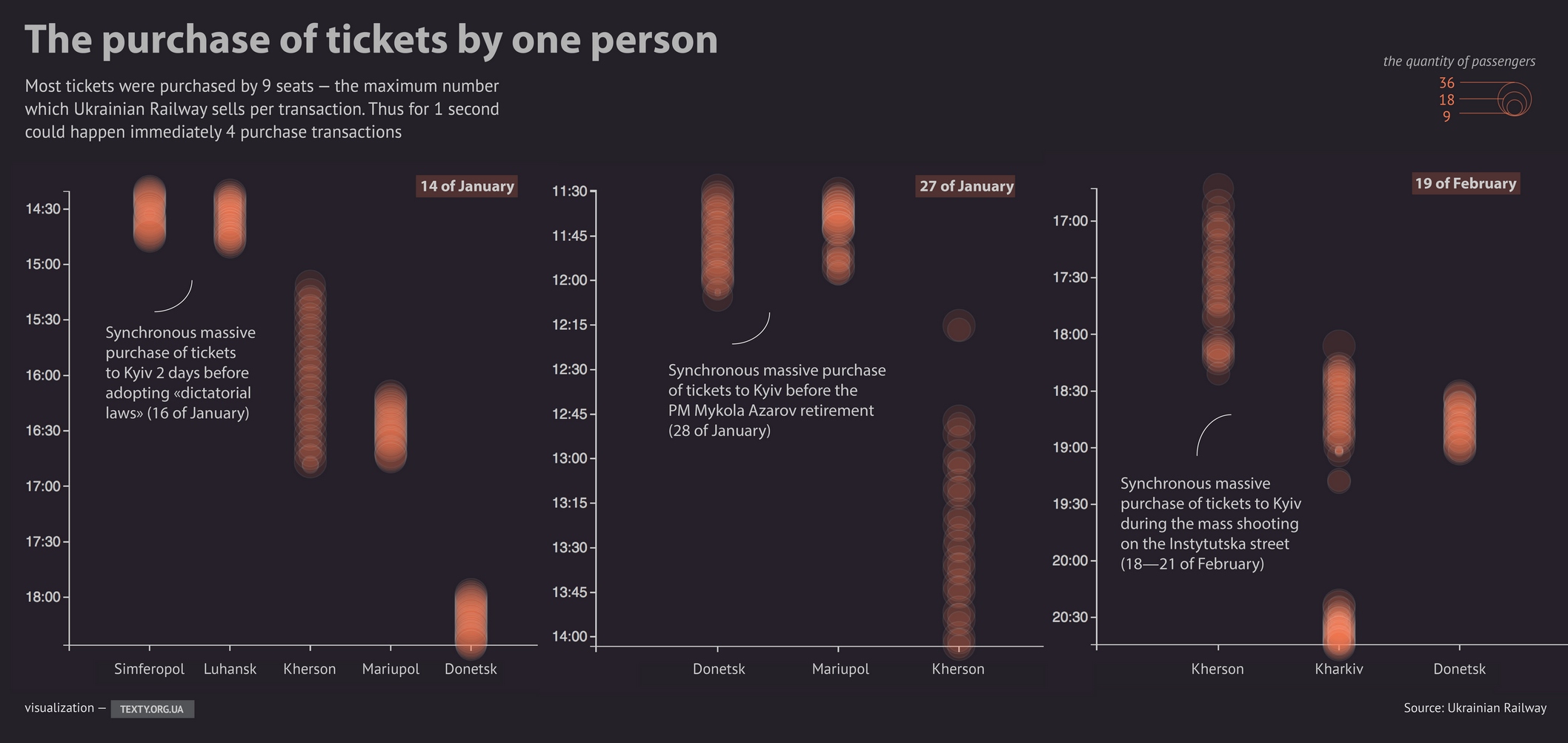
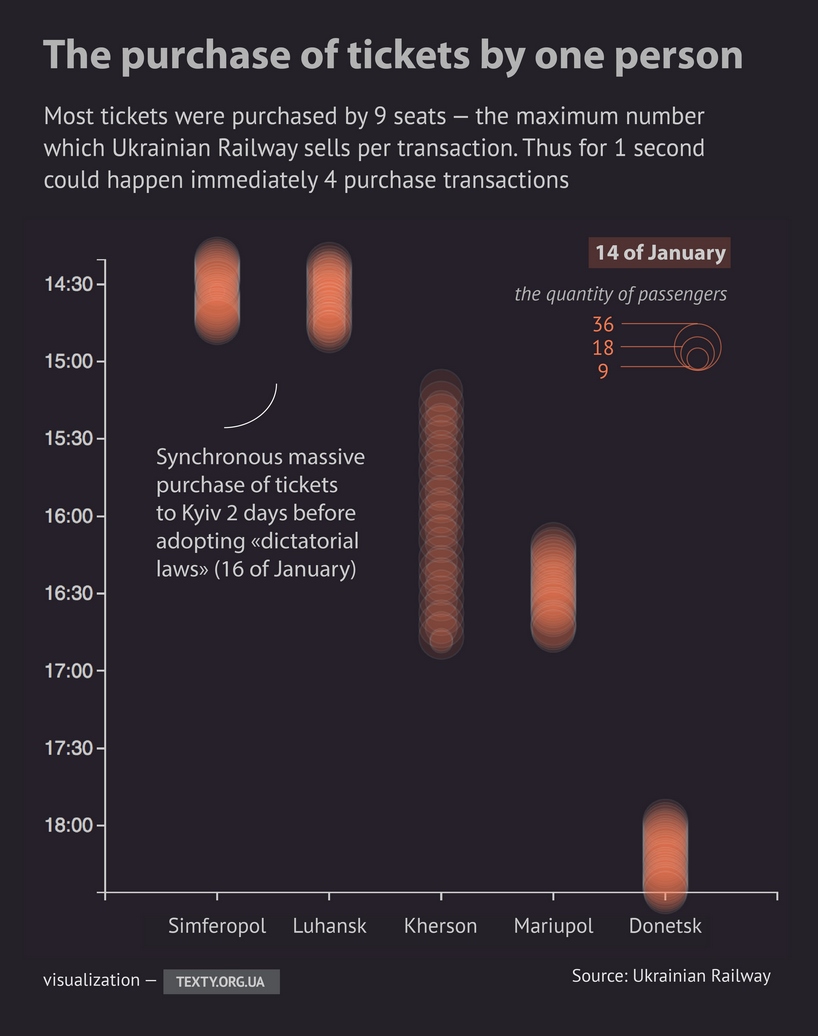
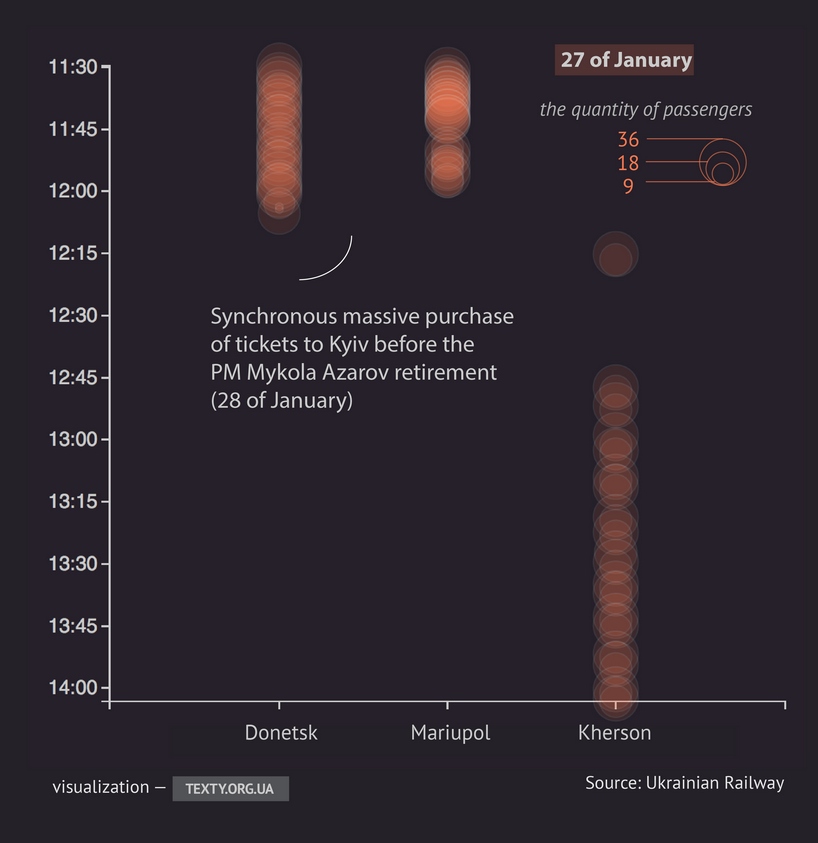
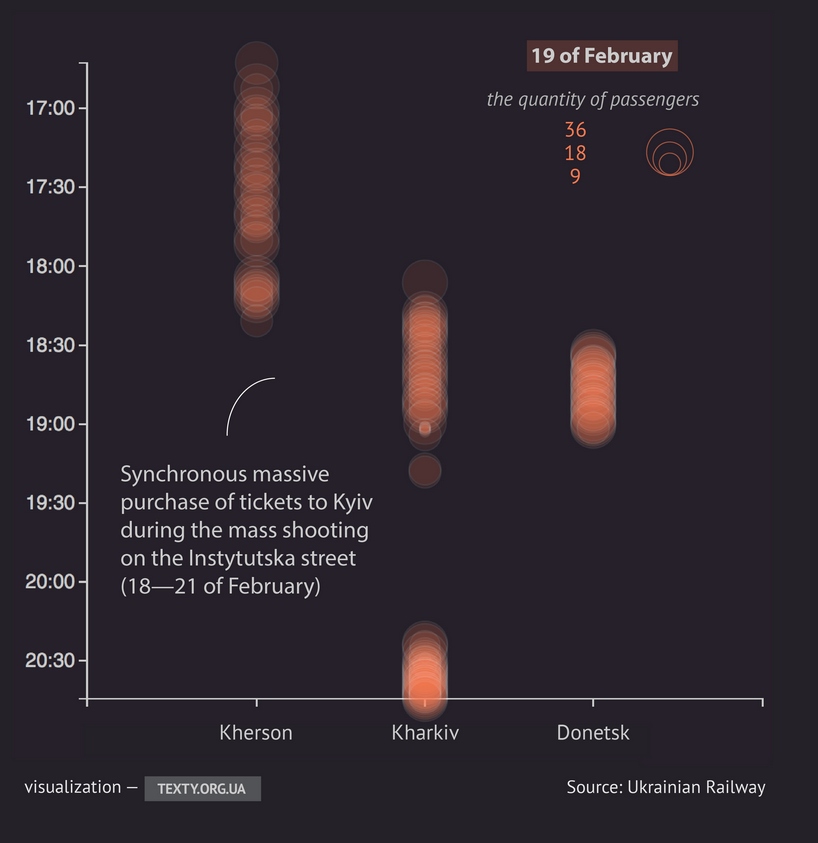
It is obvious that the sales of tickets from/to Kherson were the slowest. If they were sold in Kherson, the slowliness could be explained by the lesser number of cashiers in the ticket office, in contrast to larger offices in Kyiv and Kharkiv.
The most interesting outcome of these data is the approximate moment when the Party of Regions decided to bring yet another group of "Maidan workers" and "titushky" to Kyiv.
Look for extra info charts based on Ukrainian Railways data here.
This project has been created under the Ukrainian Think Tank Development Initiative, implemented by the International Renaissance Foundation (IRF) in partnership with the Think Tank Fund (TTF) and funded by the Embassy of Sweden in Ukraine (SIDA) and National Endowment for Democracy (NED).
The views and interpretations expressed in this publication are the authors’ and do not necessarily reflect those of the Government of Sweden.




